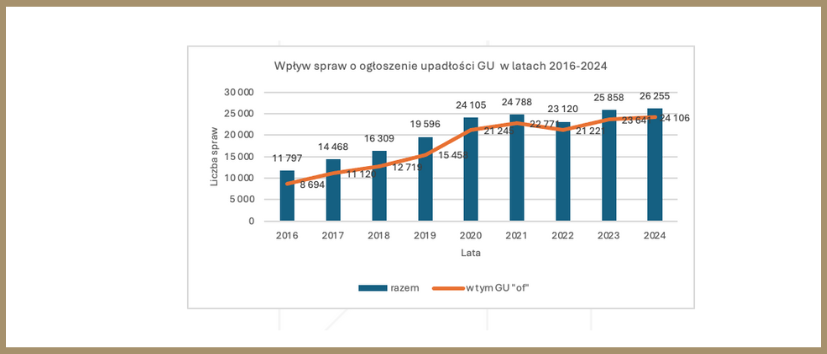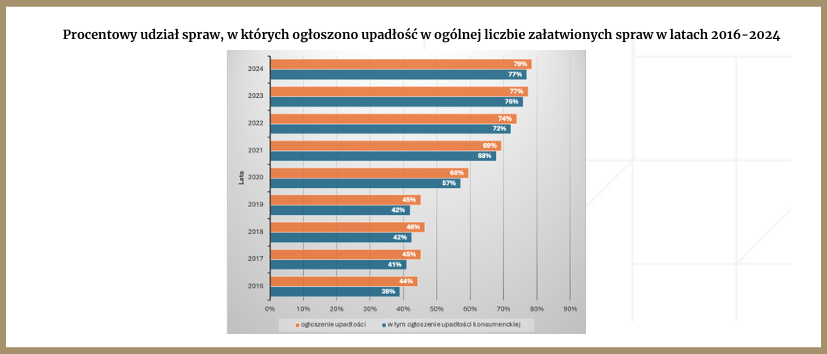Bankruptcy tourism in Poland: where are the courts operating the fastest?
Bankruptcy proceedings in Poland, they are an important element of the legal system, enabling individuals and entrepreneurs to get out of a difficult financial situation. Bankruptcy proceedings are not only becoming increasingly popular, but also diversified in terms of duration and effectiveness depending on the region. Although this procedure is unified by the provisions of bankruptcy law, in practice its course and length vary significantly depending on the place where the case is considered. However, the growing number of cases filed with courts entails systemic problems, including differences in the pace of case processing. These differences encourage some applicants to seek "more friendly" courts. This article is a starting point and, as it were, an introduction to the assessment of regional differences in the pace of case processing, as well as the characteristics of the increasingly noticeable phenomenon of so-called bankruptcy tourism.
Contents:
A few words about the article - Listen
The effectiveness of bankruptcy proceedings in recent years
At the beginning of the analysis, it should be noted that bankruptcy proceedings generally consist of 2 stages, i.e. the proceedings on declaring bankruptcy (the stage of considering the application for declaring bankruptcy – hereinafter referred to as "GU cases") and the bankruptcy proceedings proper (the stage in which the bankrupt's assets are managed by the trustee – referred to as "GUp cases"). Both stages occur in both consumer and business bankruptcies.
At this point, I encourage you to read the article entitled: Consumer Bankruptcies in Poland in 2024 – Summary and Trend Analysis, in which an expert from PMR Restrukturyzacje SA presents important information on the popularity of personal bankruptcy in the previous year.
According to data published by the Ministry of Justice, we observe a clear upward trend in the number of bankruptcy cases filed over the years 2016-2024 (the only fluctuation in the general trend is observed in 2022, which in the opinion of the author of this article is consistent with and results from the launch of the National Register of Debtors and its initial problems in operation). Statistics in this area are presented in the chart below.

From the published data it is clear that the solution is consumer bankruptcy is gaining popularity year by year, but the data on so-called business bankruptcy applications do not provide a basis for such a statement. A clear decrease in the number of cases for declaring bankruptcy of enterprises has been observed since 2020, when a memorandum was introduced regarding the obligation to file a bankruptcy application for enterprises, and at the same time solutions encouraging entrepreneurs to use restructuring came into effect. The simplification of procedures in this area encouraged entrepreneurs to attempt to "repair" their enterprises. Taking into account the experience of experts from PMR Restrukturyzacje SA, there is also a noticeable trend indicating an increased number of cases for declaring consumer bankruptcy by former entrepreneurs. The applicable regulations allow such a motion to be filed even the next day after the termination of business activity. The overlap of these two factors causes a shift in the number of cases for declaring bankruptcy of enterprises to an increase in the number of cases for declaring consumer bankruptcy and restructuring.
Due to various factors (e.g. systemic or formal), it is not always possible to consider cases. Statistics on the number of GU cases resolved in the years 2016-2024 lead to the conclusion that the change in the regulations on consumer bankruptcy, which took place in 2021 (mainly consisting in relieving the courts by moving the examination of the causes of the insolvency state from the moment the court examines the bankruptcy petition to the stage of formulating a draft creditor repayment plan by the trustee), contributed to increasing the effectiveness of resolving incoming cases. Insufficient refinement of the functioning of the KRZ system and the negligible scope of training content provided related to the launch of this system resulted in a decrease in the degree of GU case recognition in the first year of the system's operation (i.e. in 2022 - only 89% cases were recognized). The following years and the systematic improvement of the system's operation allowed the courts to "catch up" on the backlog from previous years in terms of recognition bankruptcy cases.
So how does the number of cases handled translate into the actual declaration of bankruptcy? Since 2020, there has been an increase in the percentage of decisions to declare bankruptcy in relation to the number of cases handled (see chart no. 2). The vast majority of decisions to declare bankruptcy concern consumer bankruptcies.

The efficiency of the courts in terms of hearing GU cases is also influenced by the average duration of GU proceedings. In this respect, unfortunately, no clear trends have been observed in recent years, and this time oscillates around 4-5 months (this is the period from the date of first registration to the date the case becomes final in the first instance). Data for 2024 indicate a decrease in the average duration of GU cases to around 3.8 months, and in cases of declaring consumer bankruptcy to around 3.5 months. There is no clear reason for this turn of events or whether this result will decrease further in the following years. It should be noted that this is only a national average, and the results of individual courts will differ. We should certainly not lose sight of the fact that this result also includes the time necessary to conduct the so-called deficiency proceedings - i.e. the procedure related to requesting the applicant to supplement formal deficiencies of the application, and it also includes the period necessary to establish the finality of the issued decision on declaring bankruptcy. It should not be forgotten that in the case of commercial proceedings, the duration of the GU proceedings is also influenced by the appointment of a temporary court supervisor and the activities performed by him. Nevertheless, taking into account all the steps necessary for the final recognition of the application for declaring bankruptcy and the deadline for delivering correspondence, the result achieved in the previous year seems satisfactory.
The effectiveness of bankruptcy proceedings in recent years
Referring to the statistics provided by the Ministry of Justice on relevant bankruptcy proceedings, the chart below presents average duration of the proceedings "after declaration of bankruptcy (rep. GUp)" in district courts [in months] for the years 2016-2024.

The entire procedure after declaring bankruptcy can last from several months to even several years, depending on the complexity of the case and the complexity of the debtor's assets. While the average duration of GU proceedings did not change significantly in the years 2016-2022, a significant increase in these values has been visible for the last two years. Only in the last year has there been a huge increase in the length of bankruptcy proceedings, by over 14 months compared to the previous year (2023). Data for 2024 obtained from the Ministry of Justice show that the average duration of consumer bankruptcy proceedings is 41.6 months (from the date of first registration to the date the case becomes final in the first instance). A factor explaining this state of affairs may be the fact that the number of bankruptcies announced in 2023 increased - the effect of which is both trustees' burdenand courts has increased, thereby reducing their efficiency and extending the average duration of proceedings.
Why do bankruptcy proceedings take so long?
Bankruptcy proceedings focus the attention of many entities, namely the circle of interested parties includes not only the bankrupt, but also creditors and bodies related to the proceedings - the trustee and the court. Such an extensive range of entities participating in the proceedings gives rise to many possible problems in the effectiveness the course of the entire process. Therefore, the effectiveness of bankruptcy proceedings is influenced by many factors, including:
- positive factors:
- experience of trustees,
- efficient communication between the parties,
- electronicization (e-deliveries),
- clear and complete assets of the debtor.
- negative factors:
- uneven availability of experts for property valuations,
- delays in the actions of the trustees,
- complaints from creditors prolonging the proceedings,
- abuse of the law by dishonest debtors (e.g. concealing assets).
- overload of commercial courts.
As we read in many reports on the judiciary, bankruptcy and restructuring, the key challenge for the entire system is the systematic increase in bankruptcy cases and restructuring, with a simultaneous lack of adequate staff resources in the courts.
For example:
– Allerhand Institute, Report: Recommendation for the reform of the bankruptcy and restructuring courts, Kraków 2024: " In 2018, 173 judges dealt with bankruptcy and restructuring cases in Poland. Compared to 2022, their number increased by about 60 percent - to 276. However, at the same time, the number of new restructuring proceedings has increased sevenfold, and the number of consumer bankruptcies has almost tripled. As a result, there are now significantly more cases per judge than a few years ago.”
– Supreme Audit Office, ENSURING THE EFFICIENT FUNCTIONING OF THE JUSTICE ADMINISTRATION (KPB.430.2.2024, Registration No. 89/2024/P/23/030/KPB 187/2015/P/15/025/KNO): A comparison of data for 2018 and 2023 averaged for all District Courts in Poland shows that the workload of adjudicators (including inflow and residual) has decreased significantly (approx. 25 %) in the civil division and in commercial cases, to a lesser extent (approx. 10 %) in social insurance cases and has also decreased slightly in criminal and petty offence cases. Small (a few percent) increases have been recorded in labor law and family law cases, and the largest increase was in bankruptcy and restructuring cases (by over 112 % in divisions that also considered commercial cases and by 40 % in divisions dealing with bankruptcy and restructuring cases). (…) The fundamental problem hindering the efficient functioning of courts is the excessive workload of judges, which is caused by the flawed personnel policy of the Minister of Justice and which is not supported by the constantly changing law – the Association of Polish Judges "Iustitia" summed up the analysis of statistical data for selected categories of cases in the Supreme Court for the years 2015–2020.

– Report prepared on behalf of the Analytical and Research Program of the Warsaw Institute of Banking Foundation, REFERENCE PAB/WIB 15/2024, LEGAL INFRASTRUCTURE OF THE RESTRUCTURING PROCESS IN POLAND IN THE BACKGROUND OF THE WEAKNESS OF THE POSITION OF CREDITORS: "The functioning of the bankruptcy court system in its current form is a problem not only for debtors and their creditors, but for the entire economy. Long and ineffective proceedings and poor supervision of restructuring advisors create a risk of pathology, e.g. actions of trustees contrary to the interests of creditors, as reported by the media. This undermines trust in the state apparatus as an arbiter in resolving economic disputes. (…) For several years, there has been a sharp increase in the number of restructuring and bankruptcy proceedings of enterprises in Poland. In the seven years since the entry into force of the Restructuring Law, the number of proceedings has increased more than tenfold. In the first half of 2023 alone, the number of new cases approached that recorded in 2022. This indicates that another record will be broken in the whole of 2023. (…) District courts conducting proceedings (regardless of the size of the bankrupt entrepreneur) do not have sufficient resources to effectively consider cases. Another problem is the state of the judicial staff, including the fact that adjudicating in bankruptcy cases does not give judges the opportunity for professional advancement, forcing many to leave the profession or change their specialization.”
The result of the evaluation of the effectiveness of bankruptcy proceedings is a recommendation to make further legislative and structural changes in the division of bankruptcy case processing in order to improve the operation of insolvency processes.
Summary
To sum up, it should be stated that the efficiency of the proceedings concerning the declaration of bankruptcy and bankruptcy proceedings is subject to constant changes, which are accompanied by constant fluctuations in economic processes, changing legal and economic environment, as well as different social awareness of the solutions available on the market that allow to cope with the problem of insolvency or the threat of insolvency. It is beyond doubt that the lengthiness of the conducted bankruptcy proceedings (and generally all court proceedings) reduces the beneficial impact on the economy of the entire institution of bankruptcy law, which was the legislator's intention when introducing such a solution to economic circulation. The overall functioning of the court system is influenced by the actions of individual courts and the legislator. The internal organization of work of individual courts and the resources they have allow to influence the time of considering cases more or less effectively. The general approach to the issue of insolvency is also important for applicants. judges to adjudicate, i.e. a more or less rigorous approach in terms of formal, substantive or ethical aspects, e.g. when assessing the degree of debtor's fault in the process of achieving insolvency. All this may lead to abuses in terms of preferential treatment of bankruptcy applications to courts with specific "views" and higher effectiveness of action. The next article will present information on the efficiency of proceedings in individual courts and in the area of so-called bankruptcy tourism.



























